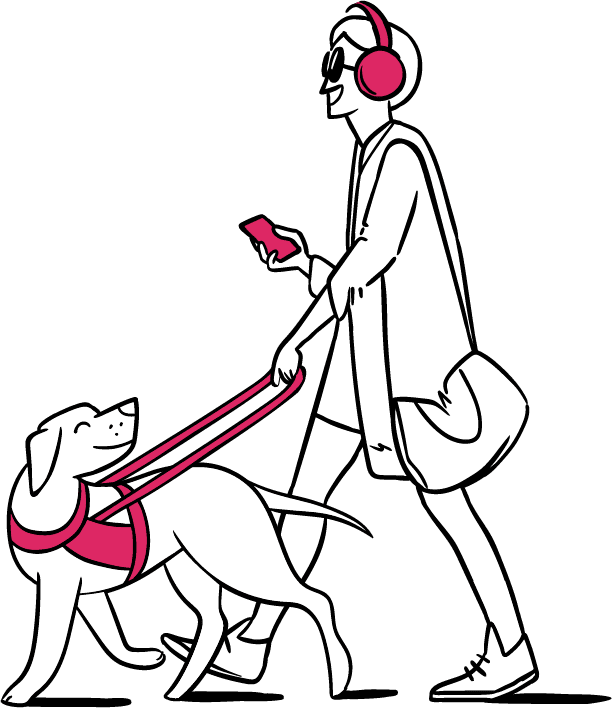
The European Accessibility Act is making usability (and profitability) a priority
The European Accessibility Act (EAA) isn’t just another piece of accessibility legislation—it’s a crossroads.
Take one path and you’re focused on accessibility audits. Take the other, and you’re making a broader commitment to both accessibility and usability. In fact, the term “usable” is written right into the background and intent behind the EAA regulations.
Recital 50 of the EAA advocates for a “design for all” approach. In practical terms, this means “the design of products, environments, programmes and services to be usable by all people, to the greatest extent possible, without the need for adaptation or specialized design.”

Kate Kalcevich
Head of Accessibility Innovation
The European Accessibility Act is making usability (and profitability) a priority
The European Accessibility Act (EAA) isn’t just another piece of accessibility legislation—it’s a crossroads.
Take one path and you’re focused on accessibility audits. Take the other, and you’re making a broader commitment to both accessibility and usability. In fact, the term “usable” is written right into the background and intent behind the EAA regulations.
Recital 50 of the EAA advocates for a “design for all” approach. In practical terms, this means “the design of products, environments, programmes and services to be usable by all people, to the greatest extent possible, without the need for adaptation or specialized design.”

Kate Kalcevich
Head of Accessibility Innovation
The $13 trillion upside of doing the right thing
Approaching accessibility through a usability lens makes it easier for people with disabilities to navigate and complete tasks. It also happens to be good for business.
People with disabilities influence more than $13 trillion dollars in global spending power. And as more users of digital products age into disabilities, like hearing loss, low vision, and memory challenges, that influence continues to grow.
Leaning into the “design for all” spirit of the EAA regulations doesn’t require throwing out all your existing processes. Rather, it’s an opportunity to re-evaluate how you approach accessible research and design.
Accessibility standards still have a place
Following standards helps teams set a baseline for compatibility with tools that people with disabilities use. Automated accessibility testing tools can be a useful first pass to catch simple accessibility errors in digital products. While standards compliance is a great starting point, it doesn’t always lead to usable outcomes.
Testing with people with disabilities adds critical context
There’s a big benefit to including people with disabilities in product design, development and QA cycles. Their insights reveal whether accessibility efforts are actually successful in making an experience usable for everyone.
Mobile apps are a great place to start
EAA 2025 doesn’t require all apps to be accessible. However, there are many apps that fall under the products or services specifically named in the legislation. Here are a few examples:
Usability barriers are a widespread problem in apps
Many apps still fall into the trap of only passing compliance checks. We know this thanks to recent data from The State of Mobile App Accessibility Report by ArcTouch. The findings reveal that people with disabilities struggle with significant barriers when using common apps.
Let’s take a closer look at the findings.
First, some context. The State of Mobile App Accessibility Report assessed the accessibility of 50 leading apps across five industries—food/delivery, payments, fitness, shopping and streaming. Researchers collected quantitative data to uncover what’s broken in app experiences. They performed qualitative testing, leveraging the Fable platform, to understand how the broken experiences impact usability.
Each app’s performance was scored against 14 different accessibility attributes and given an App Accessibility Score out of a total possible of 100.
Basic accessibility features are missing from many apps
Across all 50 apps evaluated for support of four techniques and technologies used by people with disabilities, 72% of the user journeys included accessibility barriers that resulted in a Poor or Failing grade.
- 9 apps received a Failing grade outright.
- Only 2 of the 50 apps tested achieved a Great score.
- Shopping apps received the lowest score of all industries in the report with a Poor Accessibility Score of 41. 6 of 10 shopping apps received a Poor or Failing rating, as did half of payment apps. Both shopping and payment apps fall under the updated EAA regulations.
App accessibility bright spots
The report did uncover some encouraging signs of progress in mobile app accessibility:
There is still lots of work to do to make more apps accessible in a meaningful way. The question is how to best get started.

1. Get feedback from the people with lived experience
Collecting real-world feedback from people with disabilities at regular intervals in your product development cycle is invaluable. You might be surprised at the power of people to uncover common usability challenges that automated accessibility testing tools simply can’t surface.
Ideally, you want access to a diverse community of people with disabilities using a wide range of technologies. A platform like Fable can also speed time to results by letting you skip recruitment, collect user feedback fast and tap into accessibility subject matter expertise.

2. Publish your commitments…and progress
Accessibility statements provide a way to share your organization’s commitment to achieving accessibility goals. They may also be a requirement for some organizations under the European Accessibility Act.
You can increase transparency by also sharing your progress towards stated goals by committing to continual measurement. Accessibility metrics are more important than ever as organizations want to connect initiatives to outcomes.
Users of your digital experiences have many different goals. Task completion rates help you identify whether users successfully complete tasks or run into blockers.
You may be familiar with the System Usability Scale (SUS) for measuring the perceived usability of a digital experience. The Accessible Usability Scale (AUS) is a quick, reliable, and standardized way to measure perceived accessibility of a product. It does this by tracking usability trends over time and comparing them against industry benchmarks.

3. Get the tools, skills and processes in place to succeed
If you don’t have in-house accessibility expertise you can use targeted training to build this muscle with your team. One note of caution: make sure any training you’re considering isn’t solely centered on understanding compliance.
Creating a usability mindset requires training that builds practical skills, like how to actually build accessible forms that different assistive technologies can navigate with ease. You can also explore more advanced approaches, like role-based modules with accessibility guidance specific to various product team members or guidance on how to conduct research most effectively with people with disabilities.
EAA regulations are about user experience, not just compliance
Directives in the European Accessibility Act become enforceable on June 28, 2025. This will impact many organizations, including those that don’t physically operate in the EU. Any company that offers products and services to EU residents must comply with the legislation.
On paper, it’s easy to quantify the consequences of non-compliance with EAA regulations. Penalties are clearly set out according to the national laws of each EU Member State.
In reality, it’s more challenging to precisely calculate what a lack of digital usability will cost organizations. What is clear is that businesses take a big hit when customers who can’t navigate products shift their loyalty to more accessible experiences (and share their negative brand perceptions with friends and family).
We already have the technology and tools to make digital experiences more usable for all. Design business leaders who are preparing their teams to comply with EAA regulations are in the perfect position to explore how these new approaches can fit into existing product development lifecycles.


